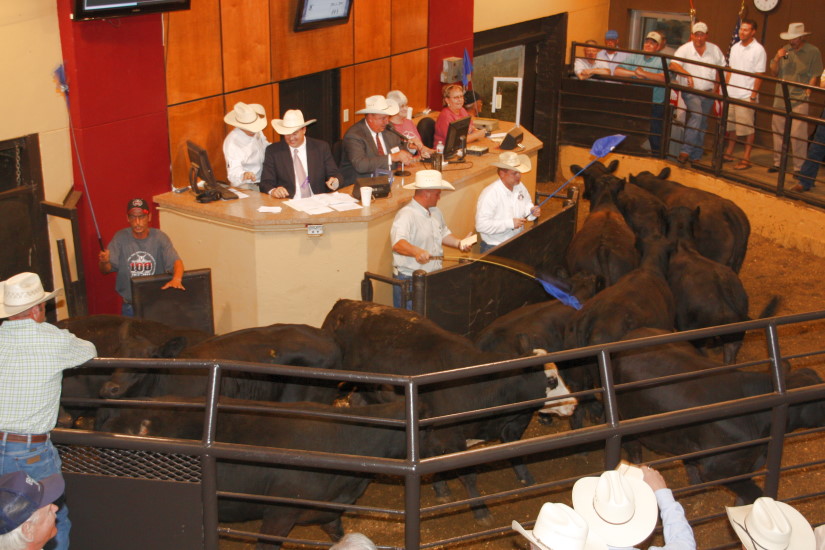
Agricultural News
Feeder Cattle Markets- Derrell Peels Calls Them the Crossroads of the Cattle Industry
Mon, 11 Jul 2016 10:18:01 CDT
 Mondays, Dr. Derrell Peel, Oklahoma State University Extension Livestock Marketing Specialist, offers his economic analysis of the beef cattle industry. This analysis is a part of the weekly series known as the "Cow Calf Corner" published electronically by Dr. Peel and Dr. Glenn Selk. Today, Dr. Peel talks about what the "job" of the market really is:
Mondays, Dr. Derrell Peel, Oklahoma State University Extension Livestock Marketing Specialist, offers his economic analysis of the beef cattle industry. This analysis is a part of the weekly series known as the "Cow Calf Corner" published electronically by Dr. Peel and Dr. Glenn Selk. Today, Dr. Peel talks about what the "job" of the market really is:
"The job of markets any market is to determine what will be produced; how much will be produced; and what resources will be used to produce; all relative to the demand for the product. The cattle industry produces fed cattle ready for slaughter. However this production mostly occurs across separate and widely dispersed sectors of cow-calf, stocker and feedlot production by producers who only interact through market transactions.
"Feeder cattle markets are the one and only place in the cattle industry where cow-calf, stocker and feedlot producers all communicate, albeit indirectly through feeder cattle prices, as cow-calf producers sell calves, stocker producers buy stockers and sell feeders and feedlots buy feeder cattle. In order to coordinate cattle markets, feeder cattle prices must simultaneously encourage cow-calf production to ensure available cattle supplies for the industry while reflecting beef demand back from consumers through fed and feeder cattle prices. In between, feeder cattle prices determine whether cattle will be produced using relatively more or less forage versus grain in the stocker and feedlot sectors. Feeder markets must reflect production conditions at the cow-calf level which, along with stocker production, depend heavily on forage conditions; and at the same time capture feed market conditions that affect feedlot production; all the while transmitting consumer demand from retail and wholesale beef markets all the way back down to the cow-calf sector. It is an enormous challenge to coordinate such a complex industry. This coordination uses not one but a constellation of feeder cattle prices across weights ranging from lightweight calves to heavy feeder cattle. The coordination is not only the result of price levels but the relationship between feeder prices across the weight range.
"In general, cow-calf producers, with a high proportion of costs that are fixed at least in the short run, respond to calf price level. Calf prices are either high enough or not to encourage more or less calf production. However since cow-calf producers use a relatively fixed forage base that often has no other use than for cattle production, changes in cow-calf production simultaneously imply retained ownership decisions as cow-calf producers consider the best way to market the forage they produce: through more weaned calves or fewer heavier, retained calves. At the other end of cattle production, feedlots are trying to assess the margins for finishing cattle driven by heavyweight feeder prices relative to fed cattle prices along with feed costs to determine whether they should be adding more or less weight to cattle using grain, in other words, do they want to buy more or less initial pounds of cattle to place and run fewer animals through the feedlot over more days or move heavier animals through the feedlot more quickly. In the short run, feedlot cost of gain is a major driver of feedlot decisions about what size and how many feeder animals to buy. These feedlot decisions simultaneously provide market signals for stocker producers to assess the potential for adding additional weight to feeder animals prior to entering the feedlot. This potential is reflected in the relationship between prices of lightweight and heavyweight feeder cattle. This relationship, often referred as the "rollback" or price slide across weights, determines the value of gain for stocker production.
"Feeder prices simultaneously impact cow-calf, stocker and feedlot production and price adjustments usually reflect impacts and market balance across all sectors. However, occasionally unusual circumstances result in market signals for one sector dominating the others. This helps to understand feeder cattle markets since 2013. The sharp post-drought decrease in beef production in 2014 and 2015 prompted dramatic calf price signals to jumpstart cow herd expansion. Hence the unprecedented increase in feeder cattle prices from mid-2013 into 2015. However, this occurred at the expense of feedlots where high feeder prices resulted in the worst feedlot losses ever in 2015. With herd expansion underway, the dramatic drop in feeder prices in late 2015 realigned feeder to fed prices and a return to more typical margins for feedlots. The result was an increase in feeder prices faster and higher than anyone anticipated in 2013 and 2014 followed by a sharper and quicker drop in prices in 2015 than anyone expected. Nothing this extreme has ever been seen in the cattle industry so no one really understood what was happening except with the benefit of hindsight.
"Cattle production is ultimately one production process that is completed in different sectors with different producers in many different places and using different resources. Anything that impacts any of the sectors must ultimately be transmitted and coordinated across all sectors. It is basic supply and demand but so much more complicated than just a question of how much should be produced. Because cattle, as ruminants, are so flexible in production, the question of how to produce cattle, i.e. what resources to use for production is very complex and dynamic as feed markets change. Much of the challenge of coordinating this complex set of production decisions occurs in the set of feeder cattle markets through changing price levels and rather subtle changes in price relationships across weights of feeder cattle."
WebReadyTM Powered by WireReady® NSI
Top Agricultural News
More Headlines...




